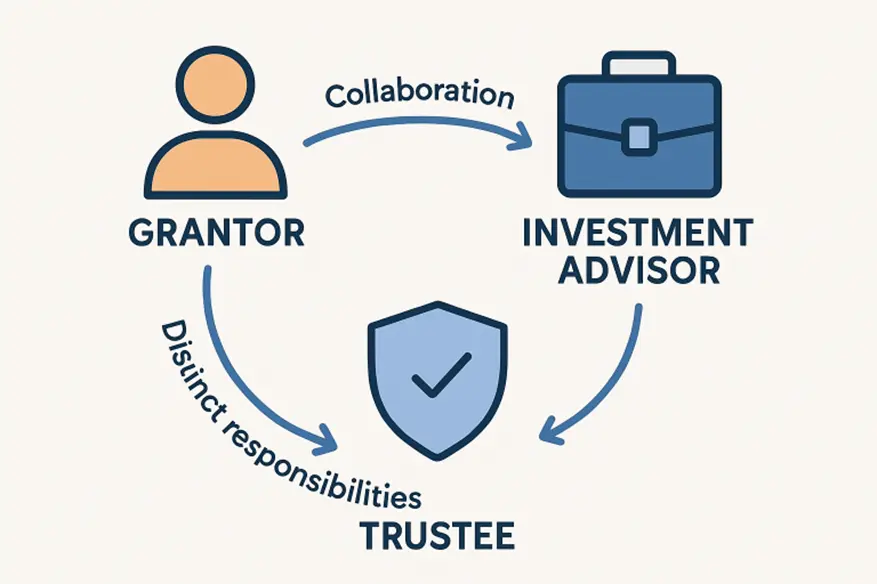What Is an Advisor-Directed Trust?
For individuals and families looking to preserve, grow, and strategically transfer their wealth, trust structures can be a cornerstone of a well-crafted financial plan. Among the various trust models available, an Advisor Directed Trust stands out for its ability to enable greater flexibility, personalized investment strategies, and stronger collaboration between trustees and clients’ chosen advisors.
An Advisor-Directed Trust divides responsibilities between a trustee who handles compliance and administration, and an investment advisor who manages investment decisions. This allows grantors to keep their trusted financial advisor, ensuring continuity and tailored oversight. The structure typically involves three parties: the grantor, the trustee, and the advisor, combining specialized expertise to deliver cohesive and customized wealth strategies. It offers flexibility and personalization, making it well-suited for modern wealth management needs.
Benefits of Integrating Advisor-Directed Trusts
Choosing an Advisor Directed Trust opens access to a wide range of benefits that align with today’s demand for flexibility in estate planning and wealth preservation:
- Customizable Investment Management: Clients are not restricted to a bank’s in-house investment offering. Instead, their selected advisor can implement a personalized investment strategy, tailored to the trust’s objectives.
- Unified Approach to Client Relationships: The client maintains a central relationship with their trusted advisor, promoting continuity, trust, and holistic management across all assets.
- Alignment with Long-Term Goals: The model facilitates collaboration on broad financial goals—such as multi-generational wealth transfers, charitable giving, or business succession—by leveraging the advisor’s long-term knowledge of the family dynamic.
Key Differences from Other Trust Models
Traditional trust models—such as those utilizing a fully delegated corporate trustee—often consolidate fiduciary powers under a single institution, which may not prioritize personalized investment approaches. Advisor-directed trusts, by contrast, enable clients to retain their independent financial advisor as the primary decision-maker for their investment strategy, while utilizing a professional trustee for administrative purposes. This division of duties gives grantors more control and engagement without sacrificing the layers of protection and expertise a trust can provide.
The scope of control and accountability for investment advisors is more pronounced in this model. Advisors are fully responsible for investment decisions, while the trustee remains focused on trust administration, reporting, and ensuring regulatory compliance. This clear division helps minimize operational conflicts.
Who Can Benefit from This Trust Structure?
Advisor-directed trusts are particularly advantageous for high-net-worth individuals and families, entrepreneurs, and business owners whose wealth may be concentrated in unique assets or complex portfolios. Clients who value an ongoing, consultative relationship with their advisor, or whose estate planning needs span multiple generations and involve charitable interests, will find this structure especially beneficial.
Specific scenarios where an advisor-directed trust excels include succession planning for family-owned businesses, asset protection strategies, and creating philanthropic legacies through customized charitable giving vehicles.
Steps to Setting Up an Advisor-Directed Trust
- Identifying the Right Team and Advisors: The process begins with selecting a qualified trustee and a trusted investment advisor familiar with the client’s needs. Legal counsel should also be engaged to ensure the trust structure aligns with state laws and accomplishes the client’s objectives.
- Establishing the Trust Document: This legal document clarifies each party’s responsibilities, outlines the investment management powers granted, and details fiduciary duties and beneficiary rights.
- Ongoing Collaboration and Communication: Success depends on regular information sharing between the trustee, advisor, and beneficiaries. Periodic reviews and transparent reporting ensure the trust stays aligned with evolving client needs and legal standards.
Common Pitfalls and How to Avoid Them
- Lack of Clear Responsibility and Communication: Dividing roles increases the need for precise definitions of authority and accountability. All parties should establish clear protocols for communication and decision-making from the outset.
- Tax Considerations and Compliance: Failure to properly structure the trust or adhere to changing tax laws can inadvertently trigger adverse tax consequences. Ongoing legal and tax consultation is crucial for maintaining compliance and minimizing liability.
- Trustee Duties and Best Practices: Trustees must stay informed of their fiduciary duties and evolving best practices. A helpful primer can be found on Investopedia, outlining the essential responsibilities and compliance standards of a trustee.
Recent Trends in Advisor-Directed Trusts
The wealth management industry is witnessing notable shifts in how trusts are designed and managed, in part due to the growing preference for advisor-directed models. There is a distinct trend toward using these trusts for multi-generational planning, allowing families to articulate and achieve enduring visions for wealth transfer and stewardship.
- Technology and Transparency Improvements: Digital platforms streamline reporting and communication, facilitating more frequent reviews and easier access for all stakeholders.
- Industry Innovations: Firms are continually launching new trust products and hybrid models to address the growing complexity of affluent families’ wealth management needs.
Is an Advisor-Directed Trust Right for Your Wealth Plan?
Before moving forward, consider your current advisor relationship, your family’s long-term goals, and the complexity of your asset portfolio. Does your advisor have the expertise to oversee your evolving needs? Are you comfortable with an independent trustee managing compliance while your advisor steers the investment strategy?
Consulting experienced financial, legal, and tax advisors is crucial as you explore whether this structure fits your unique situation. Done correctly, an advisor-directed trust can provide efficient, transparent, and highly customized solutions for complex or multi-generational wealth management challenges.
Evaluating your family’s priorities, risk profile, and anticipated legacy outcomes will help determine if this approach can streamline your wealth management for years to come.



